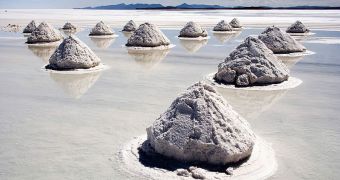According to the conclusions of a new scientific study, it would appear that regular table salt (sodium chloride) is a lot less well understood than previously thought. The material, when subjected to certain conditions, can exhibit behaviors that violate chemical predictions.
Researchers say that salt exposed to high-pressure conditions can take on forms that do not adhere to theoretical predictions, meaning that there are still many aspects of this relatively simple chemical that we are not familiar with.
In a paper published in the December 20 issue of the top journal Science, the investigators argue that this discovery may hold the key towards understanding more complex processes, such as for example how plants formed and evolved in the earliest days of the solar system.
The group, which included researchers Alexander Goncharov, Elissaios Stavrou and Maddury Somayazulu from the Carnegie Institution for Science (CIS) in Washington, used a combination of structure-prediction algorithms and new computational methods to make this discovery.
At the same time, scientists developed a series of high-pressure experiments to study the behavior of table salt. The data obtained in this manner may help solve a number of long-standing geological mysteries related to the formation of certain minerals at the core of planets such as Earth.
During the experiments, salt mixed with either molecular chlorine, or metallic sodium, was put under a diamond anvil, a device capable of exerting tremendous pressure. “We discovered that the standard chemistry textbook rules broke down,” Goncharo explains.
Under extreme pressure, standard salt (NaCl) developed new stable compounds, including Na3Cl, Na2Cl, Na3Cl2 and NaCl7. All of these chemicals exhibited interesting electronic properties and unusual patterns of chemical bonding.
“If this simple system is capable of turning into such a diverse array of compounds under high-pressure conditions, then others likely are, too. This could help answer outstanding questions about early planet cores, as well as to create new materials with practical uses,” Goncharov concludes.

 14 DAY TRIAL //
14 DAY TRIAL //